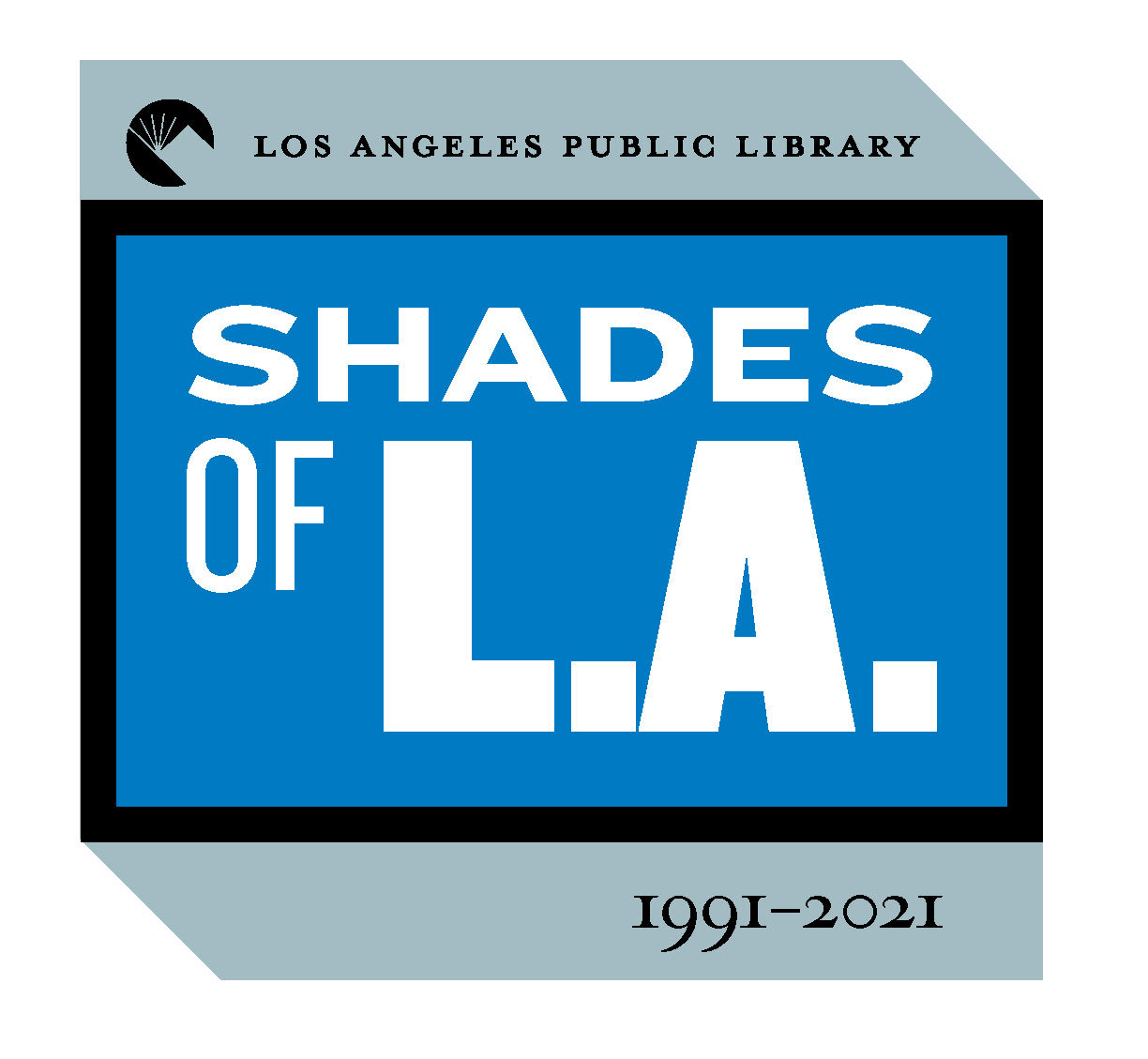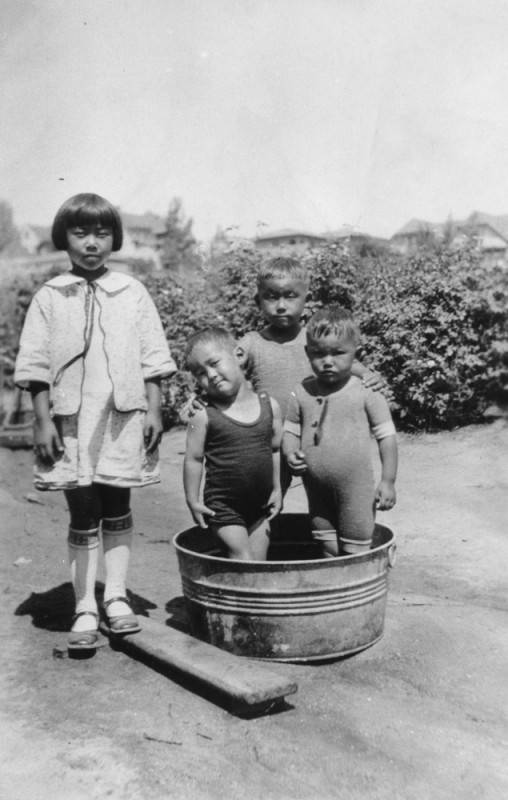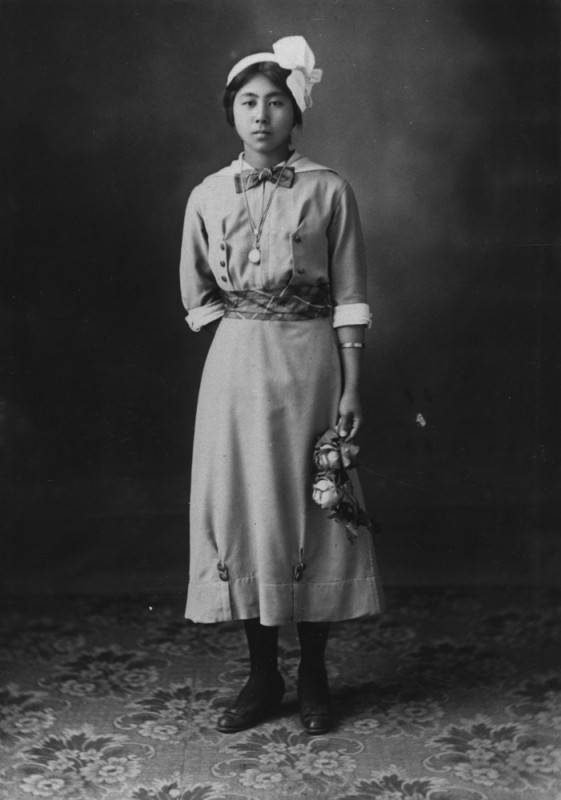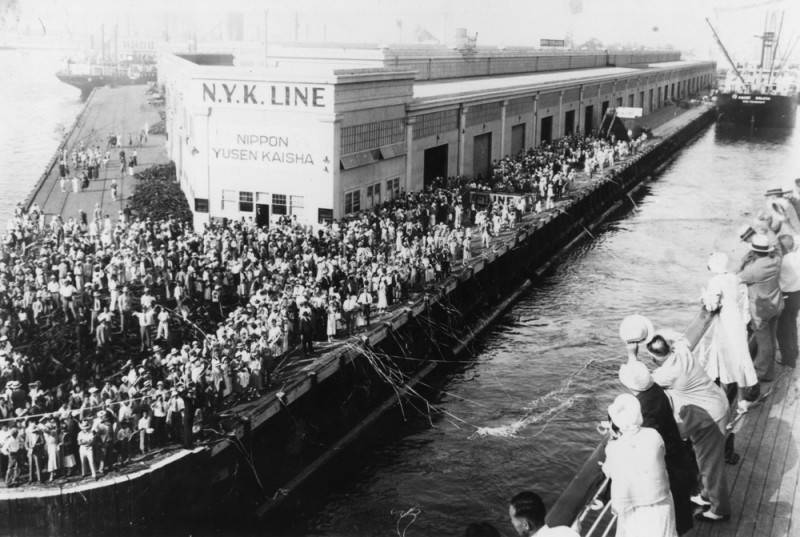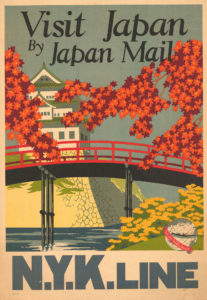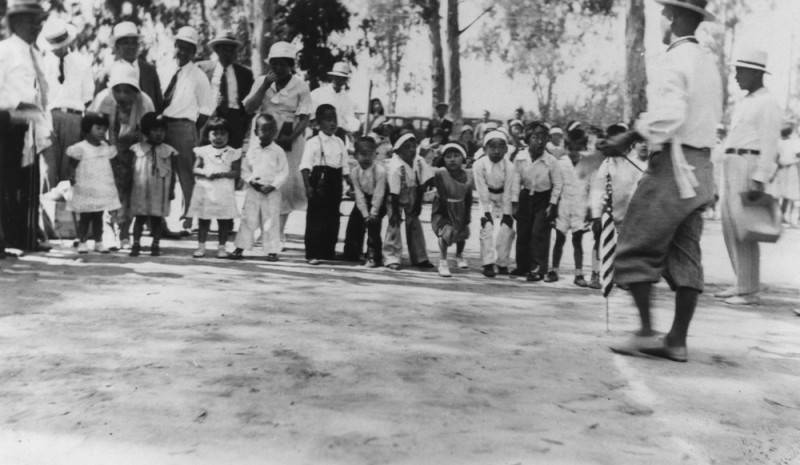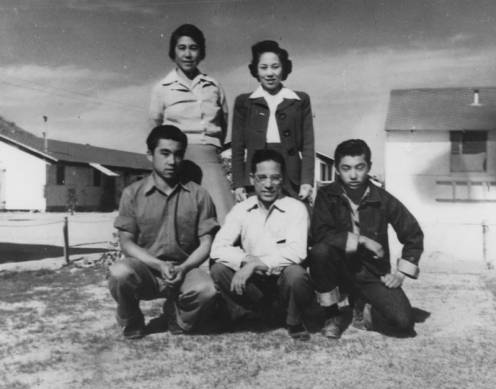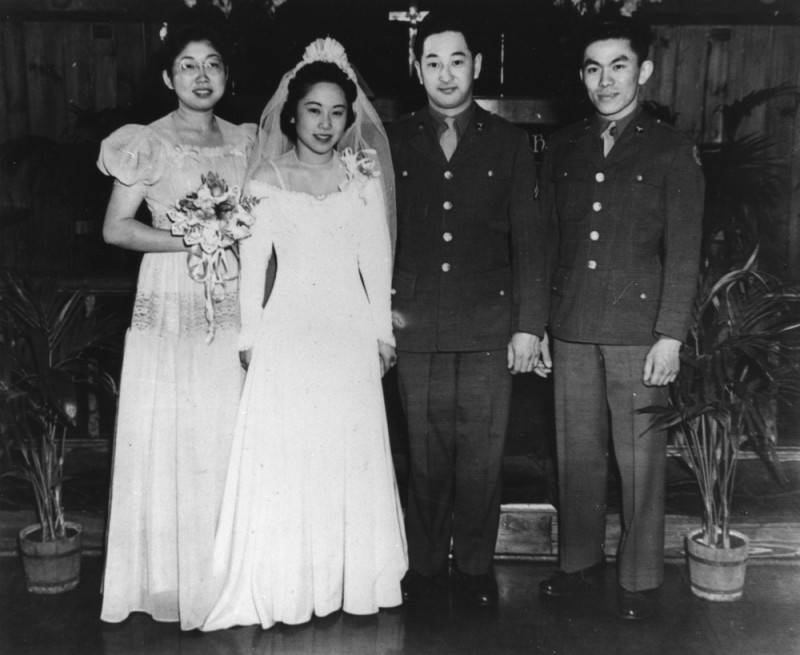Aiko Alice with her cousin Niki and brothers Hitoshi and Ise (Isamu) playing at the family’s flower farm in the Los Feliz neighborhood, about 1930. Image #00004245.
Thirty years ago the Los Angeles Public Library embarked on a ground-breaking, collection-building project – reaching out to the diverse communities of the region for family photographs that would provide depth and nuance to an understanding of this region’s multi-cultural history. The project and its results are called Shades of L.A. The support group Photo Friends of the L.A. Public Library was formed to assist in that effort. The group endures.
Los Angeles is a place literally built on the intersection of cultures: from the Tongva and other Native tribes that lived here for centuries to the Spanish, Mexican, and Black pobladores who established the pueblo in 1781, to the Hispanic and White cultures that duked it out for dominance in the early 19th century. As so often happens, the dominant culture, in this case the White American settlers, was quickly able to put their stamp on the historical narrative.
In the 20th century, Los Angeles has seen further waves of immigration, from Eastern Europe, the Middle East, East Africa, and Latin America. Asian immigration has come in distinctive waves, beginning with Chinese in the late 19th century, to Japanese and Filipinos in the first part of the 20th, and, finally, Southeast Asians, the refugees of the wars that decimated that region.
With major funding from Security Pacific National Bank and California Humanities, LAPL staff and volunteers were able to reach out to many ethnic communities and collect/copy over 7,000 images documenting family businesses, celebrations, religious and cultural traditions, and ordinary life. In addition, volunteers collected a dozen oral histories from donors. These photos and stories go far to balance the collection of the library. For a more detailed overview of the project, see https://www.lapl.org/collections-resources/photo-collection/shades-la.
A Tradition of Flowers
This essay looks at the life of Aiko Alice Ito, a Japanese American woman whose family established an enduring flower growing business in the Loz Feliz area south of Griffith Park. Ito’s story parallels that of many Nisei – the first generation of Japanese Americans born in this country. After establishing their business, the family lost it precipitously when they were “evacuated” to a concentration camp during World War II. Unlike many, the family was able to return and reestablish the business which lasted until 1961. Alice and her husband continued in the floral profession by building and running a successful retail shop on Western Avenue. They were active in both flower industry associations and Japanese American organizations.
In addition to donating use of many family photos, Alice Ito sat for an oral history interview with project director Amy Kitchener in 1993. All the quotations below are her own words. All images are from the Shades of L.A.: Japanese American Community, unless otherwise indicated.
Kiyo Kuromi, Alice’s mother, circa 1915. Shades of L.A. image #00004921.
Between two homes
Alice’s mother, Kiyo Kuromi, arrived from Japan in 1906 as a child – “in the year of the San Francisco earthquake.”
“My grandfather used to come and go [from and to Japan]. An when he found that there were much better chances for his children, he brought all three of them and then mother stayed here and the others he took back again…She remained with her uncle and he grew flowers for quite some time and then he retired and went back [to Japan] and then she was on her own here.”
Alice’s mother married a man named Harue, but it appears that the couple chose to keep Kiyo’s maiden name, Kuromi, as their surname, a relatively common practice among Japanese when a family name was at risk of dying out. Together they opened a floral nursery in the Los Feliz area of the city, in the shadow of the Griffith Observatory. Here they grew sweet peas, chrysanthemums, ranunculus, and other popular varieties, taking the cut flowers to sell at the flower market on Wall Street in downtown L.A. Alice and her two younger brothers grew up roaming and playing on the flower farm.
Sailing day in 1931. A crowd gathers to bid farewell to relatives returning to Japan. The Nippon Yusen Kaisha line also carried tourists to exotic locations before hostilities put an end to the trade. Image #00004246.
Alice’s grandfather continued to keep a foot in both countries. He embarked upon business ventures in Los Angeles, but returned to Japan every year or so. She recalled day-long excursions to see him off at San Pedro.
“If grandpa was going to Japan, it was by boat. We would see him off. We would take a picnic lunch. It was an all-day affair.”
Advertisement for N.Y.K. Japanese liners. Image # Travel_Poster-00118, Travel Poster Collection.
In 1939, when Alice was about 20, the entire family traveled to Japan to visit the ailing grandfather. Alice elected to remain in that country and attend college. In addition to beefing up her scanty Japanese language skills, she had the opportunity to study traditional arts which stood her in good stead later as a florist:
“It was a wonderful challenge. In addition to books, over the weekends I decided to fill in with flower arranging classes, the Japanese tea ceremony, silk painting, and calligraphy. There was lot there to learn! Silk painting was wonderfully relaxing. Flower arranging has been a wonderful influence because, as we went into business, I found that the basic lines were important to follow, even with the [fuller] arrangements that we have here. They do like the vines, but homes in America need a little more than the few flowers we use over there.”
Late in 1941, Alice’s sojourn in Japan was cut short when all American citizens were urged to return home. With war clouds looming, she had to scramble to find transportation back to Los Angeles.
“In my second year they asked that we return. When I was finally able to get a boat to give me passage, that ship was one of the last to unload its passengers here in San Pedro. The one right after that ship had to turn around and go back. So I was just lucky. Those friends of mine that were on that ship had to spend their lives in Japan during the war.”
Happier Times
Although the family worked long and hard at the flower farm, there were occasional outings. In addition to seeing her grandfather off at San Pedro, Alice recalls picnics small and large.
“Every so often we’d pack a picnic lunch and go either to the beach or to the park. What’s now Marina Del Rey used to be Del Rey Beach and many of the Japanese families would go down there and have their little picnics. They had a little canal* there and that’s where we used to find other Japanese American families. Another place was San Pedro — they called it White Point. We’d walk down the rocky craggy cliffs and find a spot, do a little fishing and abalone hunting. They used to have many of the prefecture [families with roots in a specific Japanese region] picnics there.”
*See our blogpost Grand Design: The Canals of Venice for a description of the canal.
Ready. Set. Go! Children line up for a foot race at a picnic sponsored by their after-school Japanese language program. Image #00004248.
“Evacuation”
The terms “evacuation” and “relocation” are euphemisms still often used to describe the forced upheaval of Japanese and Japanese Americans from the West Coast states during World War II. We described the process in our 2017 blogpost There and Back: Los Angeles Japanese and Executive Order 9066. In the spring of 1942, Alice and her family were sent first to the Santa Anita Assembly Center, a horse race track, and then to Gila River Internment Camp in Arizona.
“Well, as you know everyone had to be evacuated. And here we had this acreage and all our equipment. And so we put it into a barn, locked it up. But of course during the course of the war there wasn’t a thing left. Not one item was in there when we came back after the war. And so we started from scratch and were able to take over little bits of land which grew into forty-four acres again. And we were able to grow flowers until 1961 when the property was finally sold.”
Alice with her family at Gila River War Relocation Center, about 1942: Mother Kyo and Alice standing; father Harue kneeling center; Isamu at left; Hitoshi at right. Image #00004265.
Life in the camps was a series of indignities, including the requirement to bring one’s own eating utensils.
“They had a list of items [you could take with you]. For instance, for the mess hall they asked that we buy a tin plate and a cup so that we could get our food and line up and then — just the bare essentials. We just tried to take whatever we felt was necessary, mostly in clothing. And of course any items like knives or scissors or things of that nature were confiscated.”
In 1943 Alice was given permission to leave the camp to marry her fiancé, Arthur Ito, who was in the service. She was allowed to remain with him in Minnesota (far from the “exclusion zone”). While he served overseas, she taught Japanese to GIs.
Alice and Arthur Ito married on Valentine’s Day, 1943, in the base chapel, Camp Grant, Illinois. Image #00004253.
At war’s end, Alice’s family was allowed to return to Los Angeles where they managed to reclaim a portion of their land. Sadly, the family patriarch, Harue, took ill and passed away shortly after the return. Alice and Arthur took on the running of the business. When they sold the nursery in 1961, they opened a full-service floral shop, Flower View Gardens, on Western Avenue in Hollywood which was still open at the time of Alice’s 1993 interview.
The Itos became prominent in the flower industry and in the Japanese American community. Arthur rose to become vice president of FTD (Florist Transworld Delivery, as well as president of the Hollywood chapter of the JACL (Japanese American Citizens League). Alice became active in the Executive Women’s International, a women’s professional organization. Family papers make up 52 boxes in the Huntington Library archives.
Culture Clash
Toward the end of the interview, Alice is asked what she thinks of the many changes in Los Angeles. She describes the many waves of new immigrants and, while acknowledging the challenges population diversity brings, she sees hope for growing understanding and tolerance.
“I think we, too, as citizens have to learn [about] the cultures of all these other people that are here. However, it’s very hard to do that because it’s so completely different. For instance, the Asian community: we have the Thailand group, the Cambodians, the Vietnamese, of course mainland China; there’s a few in our area Taiwanese. And then, on the other hand, we have the Latino group and then from the Middle East we have many Armenians and I can’t even begin to tell you what nationalities are all in there. But I’m sure as citizens, it’s up to us to learn. As as business people we have to do that. We’re confronted with many of these problems because we don’t know, but I think in time, I hope, we’ll be able to understand each other a little better.”
The featured image at top shows an unidentified family in Japan, c. 1900, probably Alice’s mother’s family. Image #00004293.

